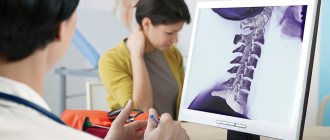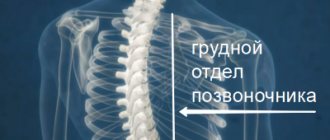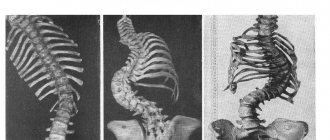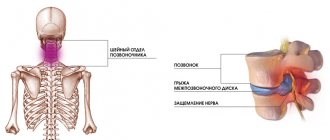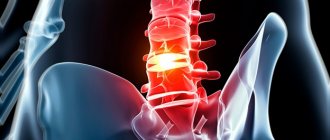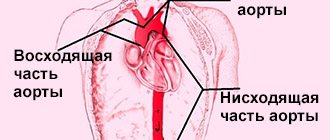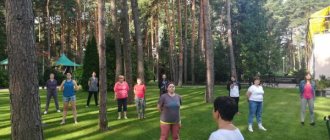Thoracic osteochondrosis is a fairly common disease of the spine. Osteochondrosis of the thoracic region is characterized by degenerative-dystrophic disorders that occur in the tissues of the spine (bones, cartilage and joints). You should check with your doctor about how to treat osteochondrosis of the thoracic spine and what are the symptoms of thoracic osteochondrosis. If you experience back pain, contact a neurologist or traumatologist. In Moscow, diagnosis and treatment of osteochondrosis is successfully performed at the Yusupov Hospital. The best doctors in the capital work here, who have extensive experience in treating this disease, and modern equipment allows an accurate diagnosis to be made in a short time.
Pain in thoracic osteochondrosis can be localized in the back or spread to various areas of the chest. In this regard, osteochondrosis is often mistaken for another pathology not related to the spine. In such a situation, the chosen treatment is ineffective, and osteochondrosis will continue to progress. Doctors at the Yusupov Hospital carry out a differential diagnosis of osteochondrosis with other diseases that manifest similar symptoms. Patients are advised by doctors and candidates of medical sciences, leading experts in the field of vertebrology.
Causes
Scientists cannot name the exact cause of thoracic osteochondrosis.
There are certain risk factors, the presence of which can provoke degenerative changes in the vertebrae. Doctors at the Yusupov Hospital begin treatment of the disease by eliminating provoking factors. Osteochondrosis most often occurs in older people. This is due to the natural processes of aging of the body: tissues become thinner, their integrity and function are impaired. Osteochondrosis occurs equally in both women and men. The disease has no age restrictions and can develop even in children.
Researchers associate the development of spinal pathology with the following factors:
- Degenerative processes in intervertebral discs;
- The presence of the disease in close relatives;
- Thinning of intervertebral discs, hernias;
- Impaired blood supply to the spinal cord;
- Diseases associated with the destruction of cartilage tissue;
- Calcium deficiency in the body;
- Violation of the structure of bone, muscle, cartilage tissue due to irrational distribution of the load on the spine;
- Curvature of the spine;
- Sedentary lifestyle;
- Engaging in active and strength sports where there is a high risk of injury;
- Mechanical damage to the spine.
When drawing up treatment programs for patients with osteochondrosis, specialists at the Yusupov Hospital take into account the causes of the development of the pathological process. Negative factors that increase the risk of developing osteochondrosis include:
- Sedentary work;
- Heavy lifting, excessive physical activity;
- Metabolic disorders in the body;
- Overweight;
- Inflammatory diseases of the tissues of the musculoskeletal system;
- Rachiocampsis;
- Bad habits.
Prevention
To avoid relapses, create comfortable conditions for sleeping and working. Watch your weight and eat right. Keep up your physical activity. But the main thing is not to neglect your health and not to skimp on it. Don't let things take their course. After recovery, try to do at least one maintenance session of gentle manual therapy once every three to six months - this will reduce risk factors. Don’t forget, advanced osteochondrosis leads to complications - protrusion and disc herniation. Remember: your health comes first!
Advanced osteochondrosis leads to complications - protrusion and disc herniation.
Symptoms
Signs of thoracic osteochondrosis intensify gradually.
At the initial stage of development of the disease, the patient may feel slight discomfort, which over time develops into severe pain. With osteochondrosis of the thoracic spine, pain can be localized not only in the back, but also spread to other parts of the chest. Pain due to osteochondrosis of the thoracic region can occur in the heart, stomach, liver, and intercostal space. This is due to the fact that the nerve roots, which are pinched as a result of disruption of the structures of the intervertebral disc and vertebrae, send distorted nerve impulses to the organs connected to them by nerve fibers. Signs of osteochondrosis of the thoracic region in the form of pain outside the spine make it difficult to make a correct diagnosis. If there is pain in the heart, the patient turns to a cardiologist, who, in turn, not finding the cause of the pain, refers the patient to another specialist. The experience of the doctors at the Yusupov Hospital allows us to immediately establish the correct diagnosis, so patients receive effective treatment in a timely manner.
Symptoms of thoracic osteochondrosis in women and men can be expressed not only in pain. Other signs of the disease are:
- Impaired mobility of the spinal column in the thoracic region;
- Impaired hand mobility;
- Numbness in the arms and hands, a feeling of “tingling” and “pins and needles”;
- Decreased sensitivity in the affected area;
- Chronic fatigue.
How does thoracic osteochondrosis manifest?
Among all types of osteochondrosis, it is the thoracic one that has vague symptoms. But it is still possible to identify the main features:
- chest pain, which intensifies at night, with a long stay in one position, cooling, turning, bending to the side, or heavy physical activity;
- pain between the shoulder blades, when raising the right or left arm, bending;
- increased pain with deep inhalation and exhalation;
- painful sensations between the ribs while walking;
- sensation as if the chest and back were being squeezed by a hoop.
During the acute course of the disease, the pain does not go away for 2-3 weeks. In this case, you should pay attention to additional symptoms. With osteochondrosis, the skin may become numb or a feeling of “pins and needles” may occur. The skin itself begins to peel off. At this time, the legs feel itching, burning, and sometimes cold. Nails become brittle.
The pathology also affects the digestive organs. A person may experience discomfort when swallowing or simply pain in the esophagus. Also, this type of osteochondrosis is accompanied by a disorder of the gastrointestinal tract.
Diagnostic methods
The sooner the correct diagnosis is made, the faster osteochondrosis of the chest will be cured.
By assessing the symptoms of the disease, the doctor makes a preliminary diagnosis and conducts additional examination of the patient. If the patient has pain outside the back area, differential diagnosis is carried out with diseases of the organ in which the person feels discomfort. Patients of the Yusupov Hospital are advised by related specialists: cardiologist, gastroenterologist. Osteochondrosis of the chest is detected using radiography. An x-ray of the thoracic spine will clearly show changes in the vertebrae. Radiography allows you to indirectly assess the degree of damage to the intervertebral discs. Osteochondrosis is a progressive pathology, so it is possible that the degenerative-dystrophic process covers several areas.
Additionally, magnetic resonance imaging or computed tomography may be required. MRI is used to determine the pathology of the intervertebral discs, cartilage and bone tissue of the vertebrae. The Yusupov Hospital uses the latest equipment from global manufacturers to diagnose osteochondrosis. High-precision diagnostic methods help to make the correct diagnosis in the shortest possible time with maximum safety for the patient’s health.
Make an appointment
Treatment
You can find a lot of information about how to treat thoracic osteochondrosis in various sources: the Internet, newspapers, from relatives and friends.
However, to receive truly effective therapy, you must consult a qualified doctor. You should not self-medicate or use questionable medications. This way you can not only not get the desired result, but also make the situation worse. Treatment of thoracic osteochondrosis is complex. It includes the use of medications and the use of physical therapy. At the Yusupov Hospital, evidence-based medicine methods are used to treat osteochondrosis, which have shown the highest effectiveness in the treatment of this pathology. The elements of therapy are selected individually, depending on the patient’s condition, his needs and characteristics. Additionally, chronic diseases are corrected if they are present.
Treatment of osteochondrosis of the thoracic spine begins with the elimination of acute pain with the help of medications. This alleviates the patient’s condition and stabilizes thoracic osteochondrosis. Drug therapy includes the use of drugs from various groups, each of which performs its own function. Neurologists prescribe the following pharmacological drugs to patients:
- Non-steroidal anti-inflammatory drugs (allows you to remove inflammation and pain);
- Painkillers (analgesics) for severe pain;
- Antispasmodics (eliminate muscle spasms);
- Chondroprotectors (improve the condition of spinal tissues, inhibit the pathological process);
- Vitamin complexes (strengthen the body's protective functions).
Medicines can be used in the form of ointments, orally, intramuscularly and in combination. The type of drug, its dosage, and duration of administration are determined only by the attending physician.
How to prevent the development of pathology?
Our doctors recommend the following prevention methods:
- during the day, lie down for 40-50 minutes - this will relieve the load on the spine;
- if you work a lot at the computer, change your position, get up from your chair every 2 hours, bend a couple of times in different directions, stretch, straighten your shoulders;
- engage in water sports: swimming, diving, water aerobics;
- do not get too cold, keep your back warm;
- Do the following exercise regularly: lying on your stomach, place your hands on the floor and bend back. Stay in this position for 5-10 seconds. Repeat the exercise 8-10 times.
Physiotherapy and exercise therapy
At the rehabilitation clinic of the Yusupov Hospital, doctors treat osteochondrosis of the thoracic spine using physiotherapeutic methods.
Specialists use various hardware techniques and physical therapy exercises. Exercise therapy and exercises for thoracic osteochondrosis are an important part of complex therapy. Special exercises help normalize spinal mobility and improve the condition of the entire body. Physical therapy can continue to be performed after the end of the main course of treatment to prevent relapse of the pathology. Massage for osteochondrosis of the thoracic spine improves blood flow and lymphatic drainage in the affected area, relaxes spasmodic muscles. During the treatment, 10 massage sessions are usually performed, which can be repeated after a certain period of time. At the Yusupov Hospital, physical rehabilitation specialists use the following methods of restorative therapy to treat thoracic osteochondrosis: acupuncture, spinal traction, electrophoresis, ultrasound, magnetic therapy, phonophoresis.
Physical therapy exercises, massage for osteochondrosis of the thoracic region, as well as other methods of physiotherapy at the Yusupov Hospital are prescribed, performed and supervised by a rehabilitation physician. The hospital staff includes professional physiotherapists, exercise therapy instructors, and massage therapists who are fluent in techniques for eliminating osteochondrosis. Complex therapy for thoracic osteochondrosis at the Yusupov Hospital helps to obtain better results, thanks to which a person can again live a full life.
Treatment at the Yusupov Hospital
Therapy for osteochondrosis of the thoracic spine is carried out at the neurology clinic of the Yusupov Hospital using the latest techniques.
Patients gradually return to active life without discomfort and pain. The Yusupov Hospital is equipped with high-precision diagnostic equipment, which makes it possible to detect even minor disorders. When drawing up a comprehensive treatment program, neurologists interact with other specialists at the Yusupov Hospital. Interdisciplinary cooperation makes it possible to achieve a positive result of therapy, which is why doctors help even those patients whose treatment was refused in other clinics.
The staff of the Yusupov Hospital ensures a comfortable stay for each patient. Cozy hospital rooms have wireless Internet, satellite TV, comfortable furniture, and communication with staff is maintained around the clock. At the Yusupov Hospital, all employees follow the tradition of attentive and friendly attitude towards the client.
If you experience pain in the thoracic spine or notice other manifestations of osteochondrosis, contact the Yusupov Hospital. Neurologists will prescribe an examination, on the basis of which they will determine the scope of therapeutic and rehabilitation measures. Registration of patients for appointments and provision of information is carried out online and by telephone by contact center staff.
Make an appointment
